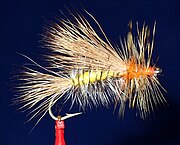Stimulator (dry fly)
| Stimulator | |
|---|---|
| Artificial fly | |
 Orange stimulator | |
| Type | Dry fly |
| Imitates | Adult stoneflies, caddis, grasshoppers |
| History | |
| Creator | Jim Slattery, Randall Kaufmann |
| Materials | |
| Typical sizes | 6-18 3X long |
| Typical hooks | TMC 200R, Firehole 718 |
| Thread | 6/0, 140 denier |
| Tail | Deer or Elk |
| Body | Dry fly dubbing, floss |
| Wing | Deer or Elk |
| Ribbing | Dry fly hackle |
| Hackle | Dry fly hackle |
| Thorax | Dry fly dubbing |
| Uses | |
| Primary use | Trout |
The Stimulator is a dry fly popularized by angler, fly tyer and author Randall Kaufmann to imitate large adult stoneflies.
Origin
The Stimulator pattern is a derivative of earlier stonefly patterns—the Improved Sofa Pillow (1940s) and Yellow-bellied Mattress Trasher (1970s). Many anglers believe the name Stimulator was given to the pattern by Jim Slattery, a Montana angler who renamed his Fluttering Stonefly pattern. Others contend the pattern was derived from the Trude style dry flies developed in 1903. However, the pattern was clearly popularized and promoted by Randall Kaufmann, a fly shop owner, angler and author in Seattle, WA and Portland, OR in the 1980s.
Imitates
Originally tied to imitate large stoneflies, the Stimulator is also useful to imitate adult caddis, grasshoppers and large mayflies.
Materials">edit]
- Hook: 3X Long Curved Dry Fly Size 6-18
- Thread: 6/0 or 140 denier matching color to pattern
- Tail: Elk, Deer or Moose hair
- Body: Dry fly dubbing matching color to pattern
- Ribbing: Short dry fly hackle palmered, typically grizzly or brown
- Wing: Deer or Elk hair
- Thorax: Dry fly dubbing matching color to pattern
- Hackle: Dry fly hackle, typically grizzly or brown
Variations
As described in Fly Patterns--Tie Thousands of Flies (2008), Randall and Mary Kaufmann
- Crystal Stimulator (Black, Gold, Green, Orange Peacock, Pearl, Royal Cerise, Tan, Yellow)
- Kaufmann's Stimulator (Green, Orange, Yellow)
- Kaufmann's Stimulator RL (Rubber Legs), (Gray, Lime, Orange, Pearl, Royal, Tan, Yellow)
Notes
- ^ a b "Attractor Fly Patterns". Rocky River Trout Unlimited. January 2022.
- ^ Hughes, Dave (1999). Trout Flies-The Tier's Reference. Mechanicsburg, PA: Stackpole Books. pp. 277–279. ISBN 978-0-8117-1601-7.
- ^ Kaufmann, Randall (1991). Tying Dry Flies-The Complete Dry Fly Instruction and Pattern Manual. Portland, Or: Western Fisherman Press. pp. 140–143. ISBN 0961705930.
- ^ Kaufmann, Randall; Kaufmann, Mary (2008). Fly Patterns-Tie Thousands of Flies. Moose, WY: Western Fisherman Press. p. 169, 236-7. ISBN 9781885212238.





